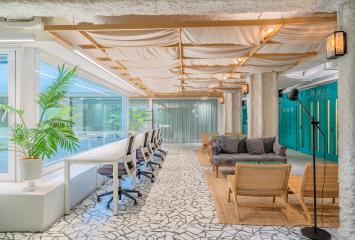The era of natural materials is making its way
We've talked countless times about biophilia, that innate connection people have with nature, which makes them feel more fulfilled and happier in environments filled with plants and water. But the concept of the natural doesn’t stop there. In reality, nature encompasses a much broader range of materials through which architects and designers can enhance the biophilia of office workers and executives, ultimately leading to better performance. The era of brick and cement is gradually drawing to a close. The era of wood, stone, and similar sustainable materials is making its way. And that’s great news: everyone benefits from this change.
Main natural materials
It's fascinating to look back at the history of architecture and see how many of the natural materials we are beginning to use today—primarily with sustainability and environmental protection in mind—were the most commonly used materials by ancient civilizations for building their homes, temples, and public buildings. Stone, for example, was fundamental in constructing houses throughout antiquity, the Middle Ages, the Modern Era, and in rural contemporary times. Its durability, resistance, low maintenance, aesthetics, and thermal insulation are its most significant advantages.
The same goes for wood. While this material has never disappeared from our lives, the invention of cement in the early 19th century relegated it to a much more marginal role in architecture. Today, two centuries later, we find ourselves in a process of rediscovering it. A paradigmatic example is Wittywood, the first office building in the country made entirely of wood. And it’s no coincidence: wood is a versatile, warm, insulating, and sustainable material if harvested ethically, with a unique ability to awaken the biophilic instinct in people.
Bamboo’s case is similar. In Europe, where it’s not a native plant, its architectural and decorative use throughout history has been anecdotal, but in other regions of the world, especially in Asia, it has played a prominent role for centuries. Bamboo's great and unusual mix of flexibility and strength, lightness, beauty, and, above all, its high sustainability—since bamboo is one of the fastest-growing plants in the world, making it a highly renewable resource—works in its favor. Today, this material is often used for flooring, as well as for decorative purposes and space dividers.
Marble, on the other hand, maintains a close relationship with Greco-Roman cultures and heritage, particularly in temples, academic buildings, public buildings, and sculptures. In a sense, it has never fallen out of use in countries like Spain, but in recent times we are seeing a broader and more widespread use of marble, perhaps due to increased interest from construction companies in investing in natural materials, even luxurious ones like marble, to protect the planet. Its benefits are varied, but if two characteristics define marble, they are elegance and durability.
Other natural materials
In addition to the four mentioned above, which are the most widely used, there is a range of alternative natural materials whose presence in architecture and interior design is growing significantly. Among these, materials with very low environmental impact, such as clay or mud, and biodegradable materials like cork, linen, jute, cane, rattan, or straw stand out. Together, these materials have the potential to create workspaces that offer benefits to all parties: reduced impact on the planet, greater personal well-being for workers, and improved professional performance for companies as a result of that well-being.

